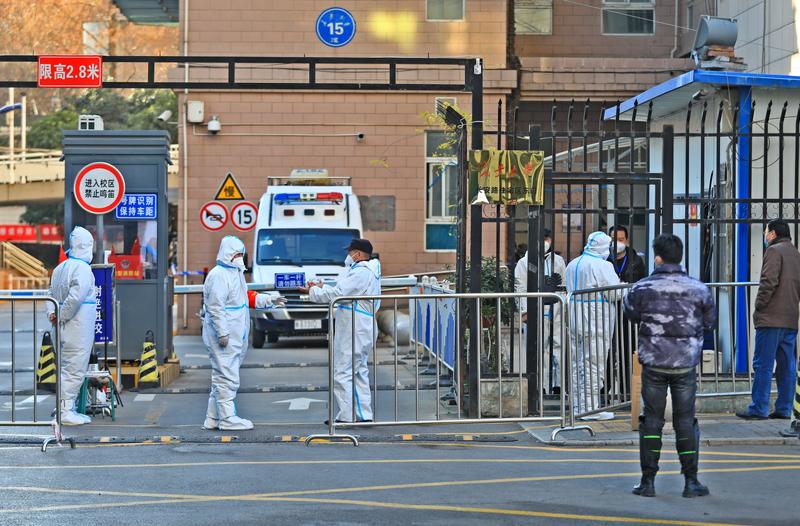People in areas of high or medium risk restricted from border crossings
 People take COVID-19 tests at a residential community in Xi'an, Shaanxi province, on Monday. More than 16 million people were tested during the mass testing campaign in the city from Saturday to Monday. (YUAN JINGZHI / FOR CHINA DAILY)
People take COVID-19 tests at a residential community in Xi'an, Shaanxi province, on Monday. More than 16 million people were tested during the mass testing campaign in the city from Saturday to Monday. (YUAN JINGZHI / FOR CHINA DAILY)
Cross-provincial travel of people living in areas with medium or high risk of COVID-19 infections will be restricted for the upcoming New Year and the Spring Festival holidays, as part of measures to ensure safe and orderly movement amid the anticipated travel rush, authorities said on Monday.
People living in district-level regions that have seen new local cases recently and have been identified as medium- or high-risk areas should not travel to other provinces during the two major holidays, the State Council's Joint Prevention and Control Mechanism said in a circular.
Transport workers responsible for shipping materials and public sector workers on business trips are exempt from the rule, but they should present negative testing results taken 48 hours before leaving, according to the circular.
For people who live in a low-risk district but in a city that has at least one medium- or high-risk district, they are advised against traveling to other provinces except for essential reasons, and they must provide negative testing results, it said.
High risk workers, including staff members at centralized isolation facilities, designated hospitals, fever clinics and cold chain plants, should avoid long-distance trips during the holidays, said the circular.
Colleges and enterprises are required to adjust their schedules for winter breaks and holidays to facilitate staggered travel of students and workers, it added.
Cross-provincial tourism will also be curbed, especially in regions experiencing recent local outbreaks and in land port cities.
These requirements take effect immediately and will be in effect until March 15.
The circular was released as the three-day New Year holiday that starts on Jan 1 and the seven-day holiday for the Spring Festival, beginning on Jan 31, are approaching.
 A students' dormitory of Chang'an University in Xi'an, Shaanxi province, was put under closed management on Monday, as it has been designated an area of high risk for COVID-19 infections. (WANG XIAOFENG / FOR CHINA DAILY)
A students' dormitory of Chang'an University in Xi'an, Shaanxi province, was put under closed management on Monday, as it has been designated an area of high risk for COVID-19 infections. (WANG XIAOFENG / FOR CHINA DAILY)
The travel rush during the two holidays has stoked concerns about the risk of the novel coronavirus spreading.
Mi Feng, spokesman of the National Health Commission, said on Monday that 89 countries and regions have reported new infections with the Omicron variant and outbreaks in neighboring countries are rapidly spreading, piling pressure on China's disease control work.
"As the New Year's Day and Spring Festival are drawing near, we must maintain vigilance against the virus, and stem its spread rapidly and assertively," he said during a news briefing.
Despite the raging pandemic, the overall domestic epidemic situation in China is stable, according to Lei Zhenglong, deputy director of the commission's disease prevention and control bureau.
He said most infection clusters across the country are under control, while outbreaks in Xi'an in Shaanxi province and Dongguan in Guangdong province are still developing.
Three cities in China have registered new imported infections with the Omicron variant. Guangzhou in Guangdong province also reported a few locally transmitted Omicron infections linked to an imported case, but Lei said the transmission risk has been contained.
China reported 37 local confirmed cases for Sunday, including one in Beijing that is associated with the outbreak in Xi'an.
The new circular also noted that virus control policies in Beijing should be firmly implemented as the 2022 Beijing Winter Olympic Games are set to open on Feb 4.Stricter movement restrictions and screening programs can be rolled out in accordance with latest risk evaluations, it said.
As of Sunday, China had delivered over 2.68 billion COVID-19 doses and fully vaccinated more than 1.19 billion people. Over 140 million children aged 3 to 11 also received vaccines, according to the commission.


